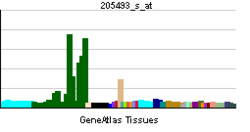- DPYSL4
-
Dihydropyrimidinase-like 4 Identifiers Symbols DPYSL4; CRMP3; DRP-4; ULIP4 External IDs OMIM: 608407 MGI: 1349764 HomoloGene: 4691 GeneCards: DPYSL4 Gene Gene Ontology Molecular function • hydrolase activity, acting on carbon-nitrogen (but not peptide) bonds, in cyclic amides Cellular component • cytoplasm
• cytosolBiological process • pyrimidine base catabolic process
• nervous system development
• axon guidanceSources: Amigo / QuickGO RNA expression pattern 

More reference expression data Orthologs Species Human Mouse Entrez 10570 26757 Ensembl ENSG00000151640 ENSMUSG00000025478 UniProt O14531 Q3TMU8 RefSeq (mRNA) NM_006426 NM_011993.4 RefSeq (protein) NP_006417 NP_036123.3 Location (UCSC) Chr 10:
134 – 134.02 MbChr 7:
146.27 – 146.29 MbPubMed search [1] [2] Dihydropyrimidinase-related protein 4 is an enzyme that in humans is encoded by the DPYSL4 gene.[1][2][3]
References
- ^ Hamajima N, Matsuda K, Sakata S, Tamaki N, Sasaki M, Nonaka M (Jan 1997). "A novel gene family defined by human dihydropyrimidinase and three related proteins with differential tissue distribution". Gene 180 (1–2): 157–63. doi:10.1016/S0378-1119(96)00445-3. PMID 8973361.
- ^ Byk T, Ozon S, Sobel A (Jul 1998). "The Ulip family phosphoproteins--common and specific properties". Eur J Biochem 254 (1): 14–24. doi:10.1046/j.1432-1327.1998.2540014.x. PMID 9652388.
- ^ "Entrez Gene: DPYSL4 dihydropyrimidinase-like 4". http://www.ncbi.nlm.nih.gov/sites/entrez?Db=gene&Cmd=ShowDetailView&TermToSearch=10570.
Further reading
- Deloukas P, Earthrowl ME, Grafham DV, et al. (2004). "The DNA sequence and comparative analysis of human chromosome 10". Nature 429 (6990): 375–81. doi:10.1038/nature02462. PMID 15164054.
- Strausberg RL, Feingold EA, Grouse LH, et al. (2003). "Generation and initial analysis of more than 15,000 full-length human and mouse cDNA sequences". Proc. Natl. Acad. Sci. U.S.A. 99 (26): 16899–903. doi:10.1073/pnas.242603899. PMC 139241. PMID 12477932. http://www.pubmedcentral.nih.gov/articlerender.fcgi?tool=pmcentrez&artid=139241.
- Weitzdoerfer R, Fountoulakis M, Lubec G (2002). "Aberrant expression of dihydropyrimidinase related proteins-2,-3 and -4 in fetal Down syndrome brain". J. Neural Transm. Suppl. (61): 95–107. PMID 11771764.
- Fukada M, Watakabe I, Yuasa-Kawada J, et al. (2001). "Molecular characterization of CRMP5, a novel member of the collapsin response mediator protein family". J. Biol. Chem. 275 (48): 37957–65. doi:10.1074/jbc.M003277200. PMID 10956643.
- Inatome R, Tsujimura T, Hitomi T, et al. (2000). "Identification of CRAM, a novel unc-33 gene family protein that associates with CRMP3 and protein-tyrosine kinase(s) in the developing rat brain". J. Biol. Chem. 275 (35): 27291–302. doi:10.1074/jbc.M910126199. PMID 10851247.
- Honnorat J, Byk T, Kusters I, et al. (2000). "Ulip/CRMP proteins are recognized by autoantibodies in paraneoplastic neurological syndromes". Eur. J. Neurosci. 11 (12): 4226–32. doi:10.1046/j.1460-9568.1999.00864.x. PMID 10594648.
Categories:- Human proteins
- Chromosome 10 gene stubs
Wikimedia Foundation. 2010.
